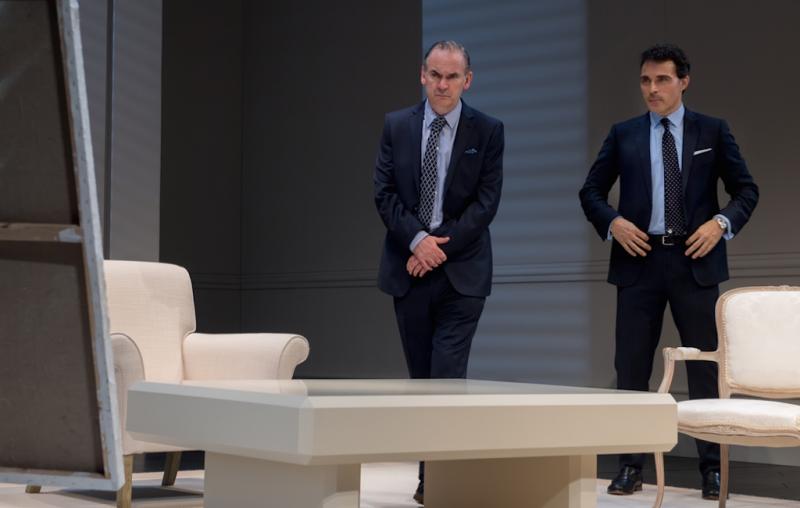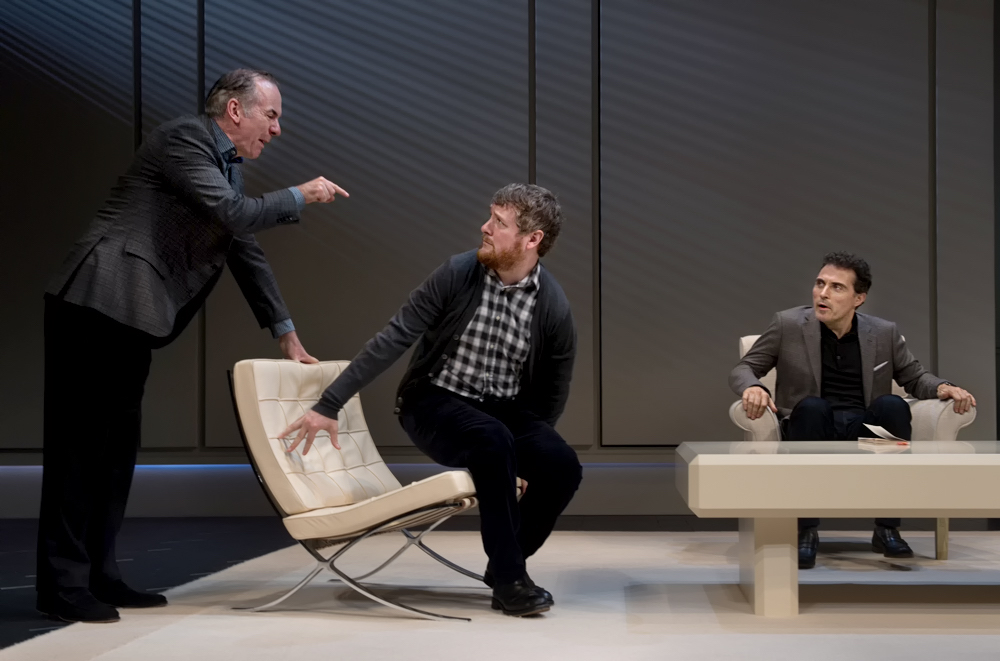Art, Old Vic | reviews, news & interviews
Art, Old Vic
Art, Old Vic
Acerbic revival of Yasmina Reza's bitterly funny comedy exploring male friendship

I avoided seeing Art when it was first staged in 1996, even though Matthew Warchus’ production created a huge buzz and won an Olivier Award for Comedy. (On receiving the award, Yasmina Reza joked that she thought she’d written a tragedy not a comedy.)
I knew the story involved an all-white painting bought for a whopping €100,000 and, in my paranoia, assumed the play was an invitation to snigger at contemporary art and anyone foolish enough to take it seriously. As a critic valiantly supporting young artists like Damien Hirst and Tracey Emin, I’d been made to squirm in front of a guffawing TV audience, and to join theatre-goers indulging similar prejudices would have been a betrayal of everything I believed in... or so I thought.
If only more men were this open and perspicacious!
I couldn’t have been more wrong. Yes, we are invited to share Marc’s view of the canvas as “a piece of white shit”, but the play is not about art per se. The painting, or rather Serge’s pride in his purchase, is the catalyst for a surgical exploration of the relationship between the three men. Can their 15-year friendship survive the differences of opinion that threaten to rip it apart when Serge claims to be culturally more progressive than his friends?
Rufus Sewell is splendid as Serge, who has spent more than he can afford in what turns out to be a gesture of defiance against his erstwhile mentor, Marc, played equally brilliantly by Paul Ritter. The cultural conservatism rejected by Serge manifests itself in the traditional landscape, View of Carcassonne, that hangs on Marc’s wall.
It's easy to empathise with Serge’s (possibly misguided) enthusiasm and to condone Marc’s outrage that his former disciple now fancies himself as a collector and connoisseur. “Of course its bollocks,” he yells in one of the excoriating remarks tossed like a vial of acid into his friend’s face. “The older I get, the more offensive I hope to become,” he announces bitterly.
 Tim Key has more difficulty gaining sympathy for Yvan, who gets hysterical, snivels a lot, quotes gobbledygook spouted by his psychoanalyst Finkelzone and, in order to keep the peace, vacillates endlessly from one point of view to the other (Tim Key, pictured above, centre).
Tim Key has more difficulty gaining sympathy for Yvan, who gets hysterical, snivels a lot, quotes gobbledygook spouted by his psychoanalyst Finkelzone and, in order to keep the peace, vacillates endlessly from one point of view to the other (Tim Key, pictured above, centre).
Mark Thompson’s set consists of three cream chairs and a coffee table surrounded by grey walls that are bare save for a painting denoting whose apartment we are in (Yvan’s picture is a still life painted by his father). But Hugh Vanstone patterns the walls with diagonal shafts of light and punctuates various scenes with dramatic lighting shifts – a cue for one of the friends to share his thoughts with the audience in a confidential aside.
Matthew Warchus keeps things moving, but to fully command the space the actors have to rely on the emotional tensions generated by their increasingly acrimonious feud. Their bitter exchanges are extremely witty and, as they become more frank with one another, their analysis of the friendship becomes ever more acute. But therein lies the problem for me; I have never met a man who had the desire or the self-awareness to reveal his feelings with such clarity and subtlety. If only more men were this open and perspicacious!
This play could only have been written by a woman, since only a woman would have the necessary degree of insight. And surely the men she portrays so vividly must be the result of wishful thinking rather than real-life experience.
- Art at the Old Vic to 18 February, 2017
- Read more theatre reviews on theartsdesk
rating
Buy
Share this article
The future of Arts Journalism
You can stop theartsdesk.com closing!
We urgently need financing to survive. Our fundraising drive has thus far raised £49,000 but we need to reach £100,000 or we will be forced to close. Please contribute here: https://gofund.me/c3f6033d
And if you can forward this information to anyone who might assist, we’d be grateful.

Subscribe to theartsdesk.com
Thank you for continuing to read our work on theartsdesk.com. For unlimited access to every article in its entirety, including our archive of more than 15,000 pieces, we're asking for £5 per month or £40 per year. We feel it's a very good deal, and hope you do too.
To take a subscription now simply click here.
And if you're looking for that extra gift for a friend or family member, why not treat them to a theartsdesk.com gift subscription?
more Theatre
 Ragdoll, Jermyn Street Theatre review - compelling and emotionally truthful
Katherine Moar returns with a Patty Hearst-inspired follow up to her debut hit 'Farm Hall'
Ragdoll, Jermyn Street Theatre review - compelling and emotionally truthful
Katherine Moar returns with a Patty Hearst-inspired follow up to her debut hit 'Farm Hall'
 Troilus and Cressida, Globe Theatre review - a 'problem play' with added problems
Raucous and carnivalesque, but also ugly and incomprehensible
Troilus and Cressida, Globe Theatre review - a 'problem play' with added problems
Raucous and carnivalesque, but also ugly and incomprehensible
 Clarkston, Trafalgar Theatre review - two lads on a road to nowhere
Netflix star, Joe Locke, is the selling point of a production that needs one
Clarkston, Trafalgar Theatre review - two lads on a road to nowhere
Netflix star, Joe Locke, is the selling point of a production that needs one
 Ghost Stories, Peacock Theatre review - spirited staging but short on scares
Impressive spectacle saves an ageing show in an unsuitable venue
Ghost Stories, Peacock Theatre review - spirited staging but short on scares
Impressive spectacle saves an ageing show in an unsuitable venue
 Hamlet, National Theatre review - turning tragedy to comedy is no joke
Hiran Abeyeskera’s childlike prince falls flat in a mixed production
Hamlet, National Theatre review - turning tragedy to comedy is no joke
Hiran Abeyeskera’s childlike prince falls flat in a mixed production
 Rohtko, Barbican review - postmodern meditation on fake and authentic art is less than the sum of its parts
Łukasz Twarkowski's production dazzles without illuminating
Rohtko, Barbican review - postmodern meditation on fake and authentic art is less than the sum of its parts
Łukasz Twarkowski's production dazzles without illuminating
 Lee, Park Theatre review - Lee Krasner looks back on her life as an artist
Informative and interesting, the play's format limits its potential
Lee, Park Theatre review - Lee Krasner looks back on her life as an artist
Informative and interesting, the play's format limits its potential
 Measure for Measure, RSC, Stratford review - 'problem play' has no problem with relevance
Shakespeare, in this adaptation, is at his most perceptive
Measure for Measure, RSC, Stratford review - 'problem play' has no problem with relevance
Shakespeare, in this adaptation, is at his most perceptive
 The Importance of Being Earnest, Noël Coward Theatre review - dazzling and delightful queer fest
West End transfer of National Theatre hit stars Stephen Fry and Olly Alexander
The Importance of Being Earnest, Noël Coward Theatre review - dazzling and delightful queer fest
West End transfer of National Theatre hit stars Stephen Fry and Olly Alexander
 Get Down Tonight, Charing Cross Theatre review - glitz and hits from the 70s
If you love the songs of KC and the Sunshine Band, Please Do Go!
Get Down Tonight, Charing Cross Theatre review - glitz and hits from the 70s
If you love the songs of KC and the Sunshine Band, Please Do Go!
 Punch, Apollo Theatre review - powerful play about the strength of redemption
James Graham's play transfixes the audience at every stage
Punch, Apollo Theatre review - powerful play about the strength of redemption
James Graham's play transfixes the audience at every stage
 The Billionaire Inside Your Head, Hampstead Theatre review - a map of a man with OCD
Will Lord's promising debut burdens a fine cast with too much dialogue
The Billionaire Inside Your Head, Hampstead Theatre review - a map of a man with OCD
Will Lord's promising debut burdens a fine cast with too much dialogue

Add comment